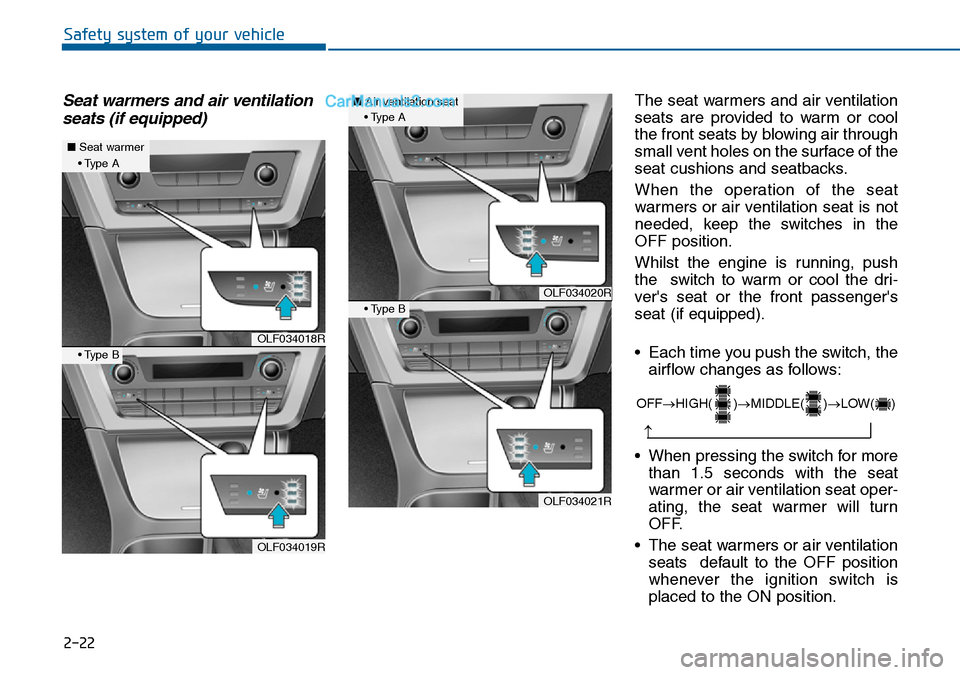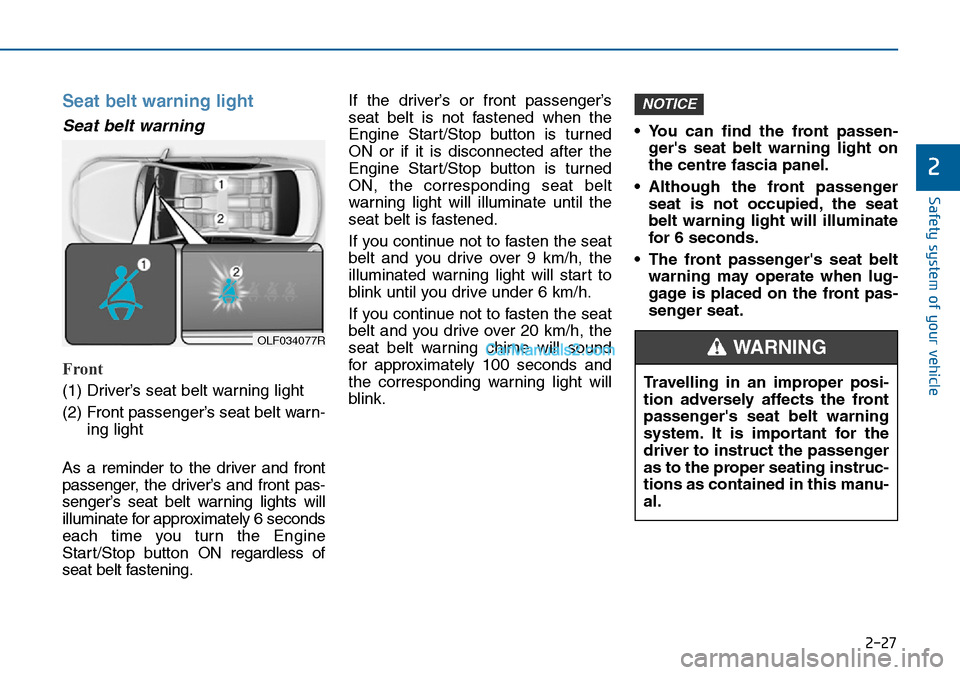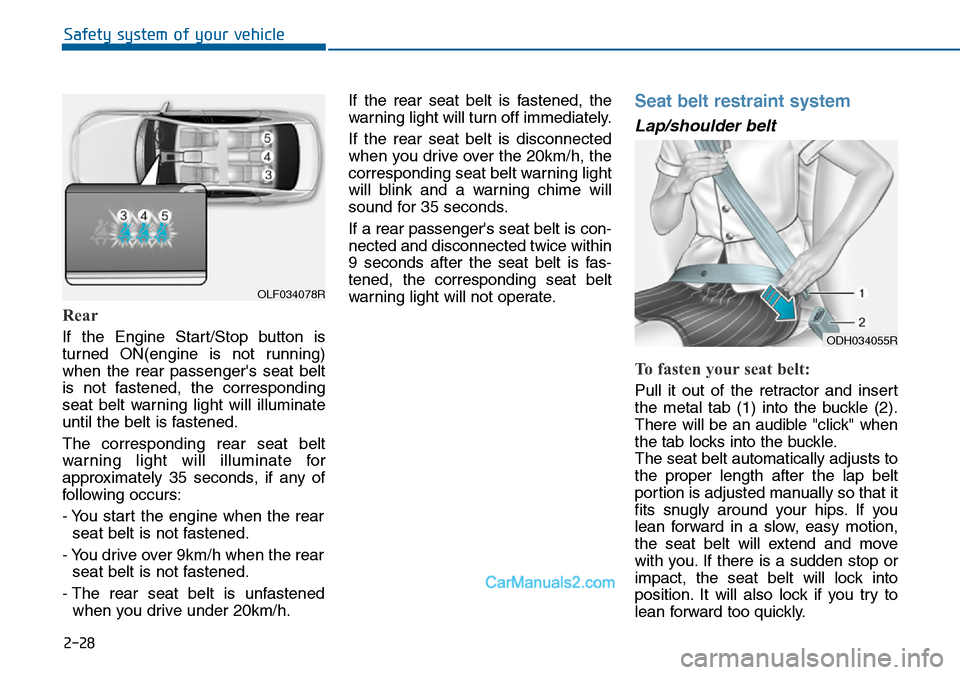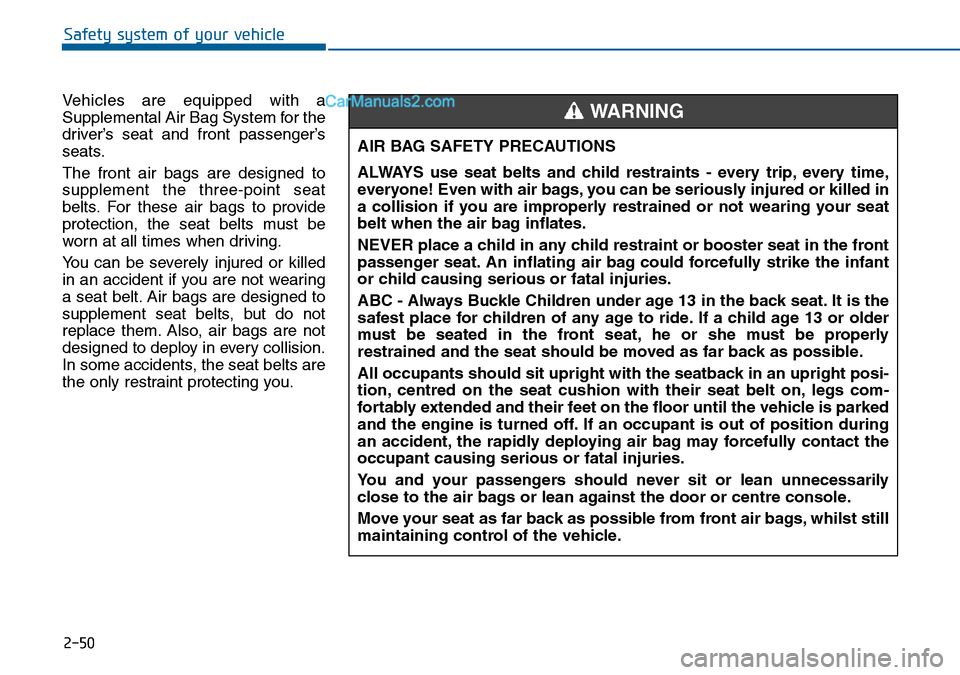Page 31 of 504
2-14
Safety system of your vehicle
Armrest
The armrest is located in the centre
of the rear seat. Pull the armrest
down from the seatback to use it.
Cup holder
To use the centre cup holder, pull
down the armrest.
OLF034065
OLF044266
Make sure the engine is off, the
shift lever is in P (Park), and the
parking brake is securely applied
whenever loading or unloading
cargo. Failure to take these steps
may allow the vehicle to move if
the shift lever is inadvertently
moved to another position.
WARNING
Page 38 of 504
2-21
Safety system of your vehicle
2
Whilst the engine is running, push
either of the switches to warm the dri-
ver's seat or front passenger's seat.During mild weather or under condi-
tions where the operation of the seat
warmer is not needed, keep the
switches in the OFF position.
• Each time you push the switch, the
temperature setting of the seat is
changed as follows :
• When pressing the switch for more
than 1.5 seconds with the seat
warmer operating, the seat warmer
will turn OFF.
• The seat warmer defaults to the
OFF position whenever the ignition
switch is in the ON position.
Information
With the seat warmer switch in the
ON position, the heating system in the
seat turns off or on automatically
depending on the seat temperature.
i
OFF HIGH ( )
LOW ( ) MIDDLE ( )
→→
→
→
OLF034016R
OLF034017R
■Type A
■Type B
Page 39 of 504

2-22
Safety system of your vehicle
Seat warmers and air ventilation
seats (if equipped)The seat warmers and air ventilation
seats are provided to warm or cool
the front seats by blowing air through
small vent holes on the surface of the
seat cushions and seatbacks.
When the operation of the seat
warmers or air ventilation seat is not
needed, keep the switches in the
OFF position.
Whilst the engine is running, push
the switch to warm or cool the dri-
ver's seat or the front passenger's
seat (if equipped).
• Each time you push the switch, the
airflow changes as follows:
• When pressing the switch for more
than 1.5 seconds with the seat
warmer or air ventilation seat oper-
ating, the seat warmer will turn
OFF.
• The seat warmers or air ventilation
seats default to the OFF position
whenever the ignition switch is
placed to the ON position.
OFF→HIGH( )→MIDDLE( )→LOW( )
→
OLF034018R
OLF034019R
■Seat warmer• Type A
• Type B
OLF034020R
OLF034021R
■Air ventilation seat• Type A
• Type B
Page 41 of 504
2-24
Safety system of your vehicle
Rear seat warmers (if equipped)
Whilst the engine is running, push
either of the switches to warm the rear
seat.
During mild weather or under condi-
tions where the operation of the seat
warmer is not needed, keep the
switches in the OFF position.Each time you push the switch, the
temperature setting of the seat is
changed as follows :
The seat warmer defaults to the OFF
position whenever the ignition switch
is placed in the ON position.
Information
With the seat warmer switch in the
ON position, the heating system in the
seat turns off or on automatically
depending on the seat temperature.
i
OFF →HIGH ( ) →LOW ( )
→
OLF034028
Page 44 of 504

2-27
Safety system of your vehicle
Seat belt warning light
Seat belt warning
Front
(1) Driver’s seat belt warning light
(2) Front passenger’s seat belt warn-
ing light
As a reminder to the driver and front
passenger, the driver’s and front pas-
senger’s seat belt warning lights will
illuminate for approximately 6 seconds
each time you turn the Engine
Start/Stop button ON regardless of
seat belt fastening.If the driver’s or front passenger’s
seat belt is not fastened when the
Engine Start/Stop button is turned
ON or if it is disconnected after the
Engine Start/Stop button is turned
ON, the corresponding seat belt
warning light will illuminate until the
seat belt is fastened.
If you continue not to fasten the seat
belt and you drive over 9 km/h, the
illuminated warning light will start to
blink until you drive under 6 km/h.
If you continue not to fasten the seat
belt and you drive over 20 km/h, the
seat belt warning chime will sound
for approximately 100 seconds and
the corresponding warning light will
blink.• You can find the front passen-
ger's seat belt warning light on
the centre fascia panel.
• Although the front passenger
seat is not occupied, the seat
belt warning light will illuminate
for 6 seconds.
• The front passenger's seat belt
warning may operate when lug-
gage is placed on the front pas-
senger seat.
NOTICE
2
OLF034077R
Travelling in an improper posi-
tion adversely affects the front
passenger's seat belt warning
system. It is important for the
driver to instruct the passenger
as to the proper seating instruc-
tions as contained in this manu-
al.
WARNING
Page 45 of 504

2-28
Rear
If the Engine Start/Stop button is
turned ON(engine is not running)
when the rear passenger's seat belt
is not fastened, the corresponding
seat belt warning light will illuminate
until the belt is fastened.
The corresponding rear seat belt
warning light will illuminate for
approximately 35 seconds, if any of
following occurs:
- You start the engine when the rear
seat belt is not fastened.
- You drive over 9km/h when the rear
seat belt is not fastened.
- The rear seat belt is unfastened
when you drive under 20km/h.If the rear seat belt is fastened, the
warning light will turn off immediately.
If the rear seat belt is disconnected
when you drive over the 20km/h, the
corresponding seat belt warning light
will blink and a warning chime will
sound for 35 seconds.
If a rear passenger's seat belt is con-
nected and disconnected twice within
9 seconds after the seat belt is fas-
tened, the corresponding seat belt
warning light will not operate.
Seat belt restraint system
Lap/shoulder belt
To fasten your seat belt:
Pull it out of the retractor and insert
the metal tab (1) into the buckle (2).
There will be an audible "click" when
the tab locks into the buckle.
The seat belt automatically adjusts to
the proper length after the lap belt
portion is adjusted manually so that it
fits snugly around your hips. If you
lean forward in a slow, easy motion,
the seat belt will extend and move
with you. If there is a sudden stop or
impact, the seat belt will lock into
position. It will also lock if you try to
lean forward too quickly.
Safety system of your vehicle
OLF034078R
ODH034055R
Page 67 of 504

2-50
Safety system of your vehicle
Vehicles are equipped with a
Supplemental Air Bag System for the
driver’s seat and front passenger’s
seats.
The front air bags are designed to
supplement the three-point seat
belts. For these air bags to provide
protection, the seat belts must be
worn at all times when driving.
You can be severely injured or killed
in an accident if you are not wearing
a seat belt. Air bags are designed to
supplement seat belts, but do not
replace them. Also, air bags are not
designed to deploy in every collision.
In some accidents, the seat belts are
the only restraint protecting you.AIR BAG SAFETY PRECAUTIONS
ALWAYS use seat belts and child restraints - every trip, every time,
everyone! Even with air bags, you can be seriously injured or killed in
a collision if you are improperly restrained or not wearing your seat
belt when the air bag inflates.
NEVER place a child in any child restraint or booster seat in the front
passenger seat. An inflating air bag could forcefully strike the infant
or child causing serious or fatal injuries.
ABC - Always Buckle Children under age 13 in the back seat. It is the
safest place for children of any age to ride. If a child age 13 or older
must be seated in the front seat, he or she must be properly
restrained and the seat should be moved as far back as possible.
All occupants should sit upright with the seatback in an upright posi-
tion, centred on the seat cushion with their seat belt on, legs com-
fortably extended and their feet on the floor until the vehicle is parked
and the engine is turned off. If an occupant is out of position during
an accident, the rapidly deploying air bag may forcefully contact the
occupant causing serious or fatal injuries.
You and your passengers should never sit or lean unnecessarily
close to the air bags or lean against the door or centre console.
Move your seat as far back as possible from front air bags, whilst still
maintaining control of the vehicle.
WARNING
Page 72 of 504

2-55
Safety system of your vehicle
2
During a frontal collision, sensors will
detect the vehicle’s deceleration. If the
rate of deceleration is high enough,
the control unit will inflate the front air
bags, at the time and with the force
needed.
The front air bags help protect the
driver and front passenger by
responding to frontal impacts in
which seat belts alone cannot provide
adequate restraint. When needed,
the side air bags help provide protec-
tion in the event of a side impact.
• Air bags are activated (able to
inflate if necessary) only when the
ignition switch is in the ON position.
• Air bags inflate in the event of cer-
tain frontal or side collisions to help
protect the occupants from serious
physical injury.
• There is no single speed at which
the air bags will inflate. Generally,
air bags are designed to inflate
based upon the severity of a colli-
sion and its direction. These two
factors determine whether the sen-
sors produce an electronic deploy-
ment/inflation signal..• Air bag deployment depends on a
number of factors including vehicle
speed, angles of impact and the
density and stiffness of the vehicles
or objects which your vehicle
impacts during a collision. The
determining factors are not limited
to those mentioned above.
• The front air bags will completely
inflate and deflate in an instant. It is
virtually impossible for you to see
the air bags inflate during an acci-
dent. It is much more likely that you
will simply see the deflated air bags
hanging out of their storage com-
partments after the collision. (Continued)
•The light stays on after illumi-
nating for approximately 6
seconds.
•The light comes on whilst the
vehicle is in motion.
•The light blinks when the
engine is running.
We recommend that an autho-
rised HYUNDAI dealer inspect
the SRS as soon as possible if
any of these conditions occur.